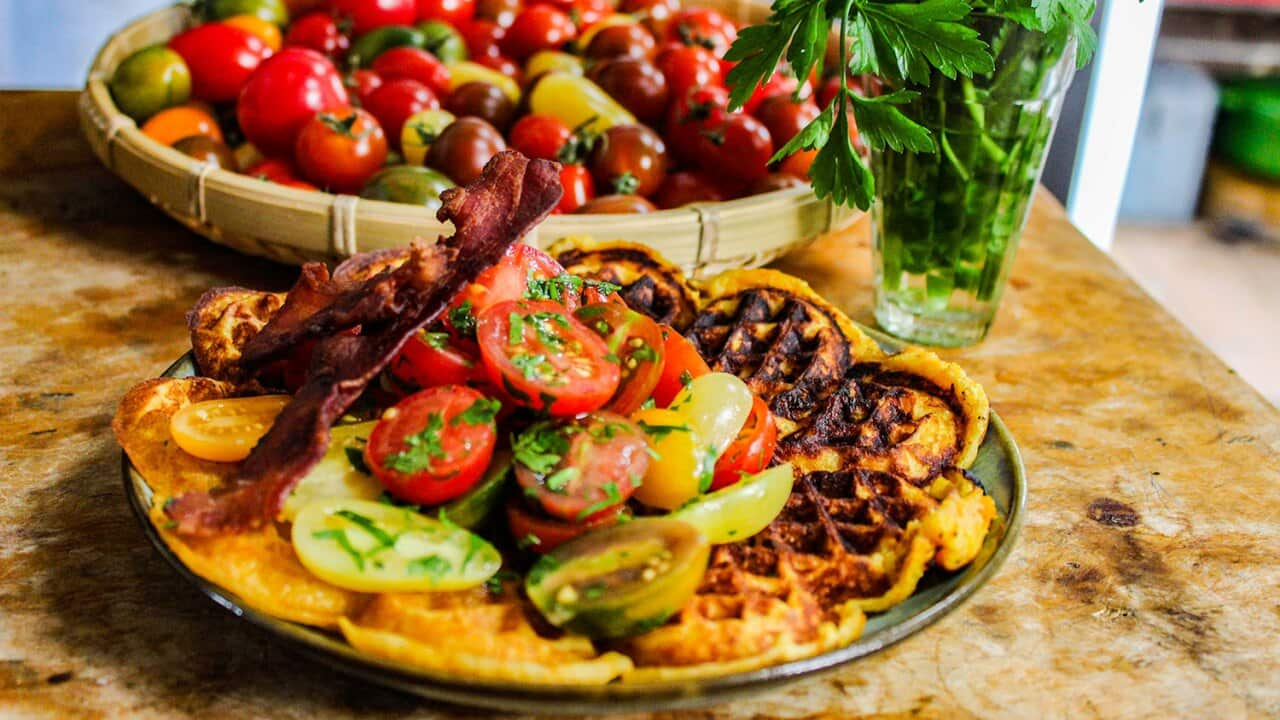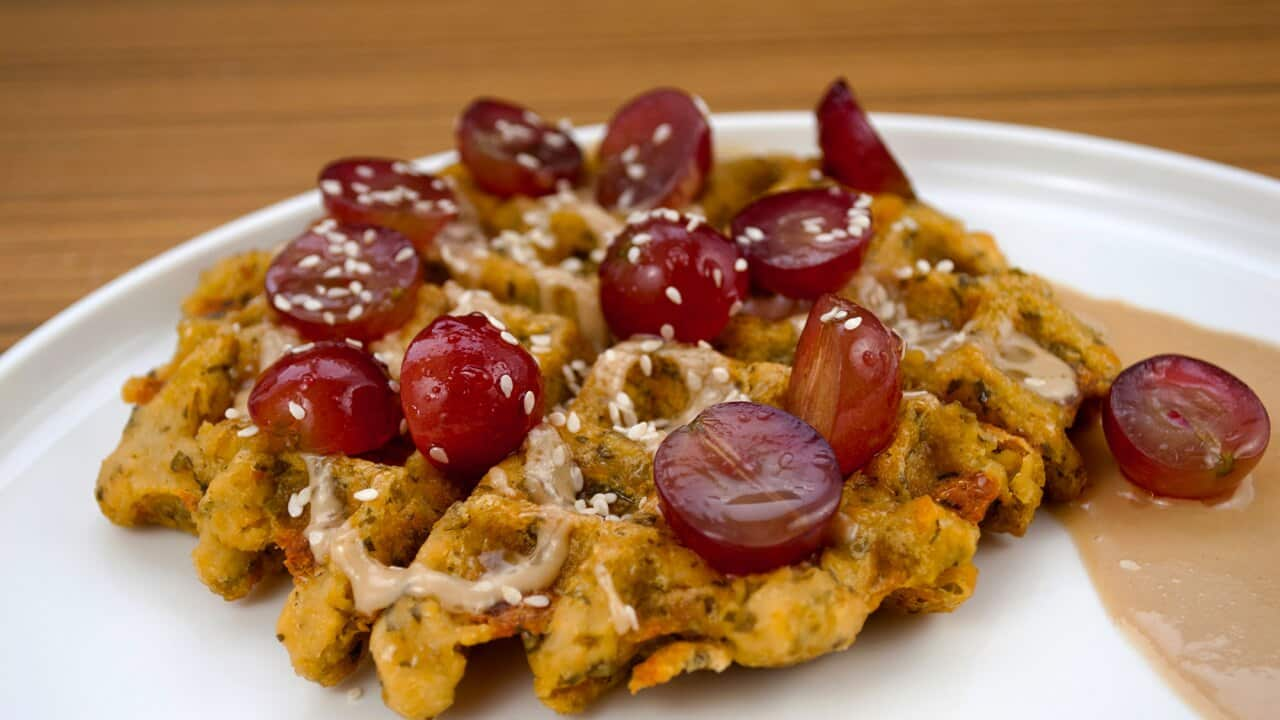Stream free On Demand

The Streets Hong Kong
series • cooking
G
series • cooking
G
What began as a way for hawkers in 1950s Hong Kong to use up excess broken eggs, these handheld waffle goodies have now become a childhood favourite for Hong Kong locals and visitors alike, even earning a .
Today, these have evolved into an elaborate dessert item, topped with everything from cream, fruit, wafers, ice cream, and even fried chicken and maple syrup!
And it's not just the toppings that change - the batter itself goes through its own variations: from something as classic as chocolate chips to the more adventurous cheese and pork floss. I've even seen this in the frozen section at the supermarket.

Source: Tammi Kwok
Here's my deep dive into the egg waffle at home.
The gear

Source: Tammi Kwok
So I've opted for the stovetop version of the iron. Cause how wrong can you go with $30, right?
Yeah, more about that later.
The ingredients
At its core, the egg waffle batter is very similar to a European waffle batter, with the addition of a few special ingredients: custard powder (to add to its luscious eggy-ness), tapioca flour (which aids in a crisp exterior, and a mild chewiness to the interior), and evaporated milk (makes the batter more creamy, but also because fresh milk used to be a luxury).
The waffle

Source: Tammi Kwok

Source: Tammi Kwok
The results
Originally, it seems pretty straightforward - make up the batter, and cook according to the manufacturer's instructions (med-low heat for 2-3 mins on each side). Turns out, that there is a lot more to it!

Source: Tammi Kwok
So it was back to the drawing board - I had enough batter for a few goes, and I was determined to get as close as I possibly could.

Source: Tammi Kwok
Cooking waffles 4 ways
Oven-baked
To combat the uneven colour, a friend suggested that I heat the pan in the oven rather than over the stove. So I wrapped the handles in foil and heated it to 200°C for 30 mins, before pouring in the batter and returning it to the oven to finish cooking.
This provided the most evenly cooked of the lot, but unfortunately, this also applied to the interior. Everything was cooked to the same doneness, which meant that I didn't get the crispy exterior and soft bite that is so essential to the classic egg waffle.
High pre-heat on the stove
Another thought I had to mimic the commercial electric waffle iron was to heat the pan on the stove on high and then turn the heat down to finish cooking the waffle. This got me closer to the juxtaposition of textures that I was looking for, but the outsides had over-crisped by the time the waffles would release - the steam created in the cooking process created suction in the little egg-shaped pockets, and the waffle exterior needed to get dry enough before the non-stick coating could do its job.
Also, heating the pan on the stove meant that one side was screaming hot, while the other side was just too cold, resulting in a batter that wasn't even a similar done-ness on both sides.

Source: Tammi Kwok
Maybe the pre-heating was the problem, so this time I went for medium heat. I had a similar issue of one side being hotter than the other, but at least this time it didn't burn. This had a nice springy quality to the waffle, but also suffered the same curse of not releasing until the insides were overcooked. It had a rather cakey texture to it, with no chew.
Low heat on the stove (no pre-heating)
I had just enough batter leftover for one more (just!) so why not? Starting with a cold pan, I turned my burner down to its lowest setting. This waffle gave me a little of the exterior shine that I was looking for but turned out fairly similar to the oven-baked waffle. There wasn't much variation to the texture and it had a cakey quality that I personally wasn't a fan of.
Conclusion
Unfortunately, I never quite hit that perfect mix of crunchy-on-the-outside-fluffy/chewy-on-the-inside that you get from a store-bought egg waffle. As with much of cooking, temperature control and even heating are so important, and the bumpy shape of the egg waffle makes it nearly impossible to do manually, in a home setting.
We could probably mimic the results with a commercial electric egg waffle iron, but that's another $150 to find out.
Or, you know, you could also just pay the $5.50 and spring for one from the store.
Hong Kong egg waffle
By Farah Celjo
Serves 2
- 1 cup plain flour
- 1 tsp baking powder
- 2 tbsp tapioca flour
- 2 tbsp custard powder
- 2 large eggs
- ½ cup water
- ¼ cup evaporated milk
- 1 tsp vanilla extract
- ½ cup sugar
- 50 ml vegetable oil
- Pinch of salt
1. Sift flour, baking powder, tapioca, custard powder in a bowl Stir through the salt.
2. In a separate bowl, whisk the eggs, water, evaporated milk, vanilla and sugar and oil until combined.
3. Add the wet mixture into the dry and whisk to form a smooth batter.
4. Grease your eggette plate or waffle iron with a little oil or non-stick spray and heat. Pour ½ - ¾ cup of batter, depending on the size of the size onto the plate/iron, ensuring the batter is evenly spread across your pan.
5. Cook for 2-3 minutes, flip and cook for another 2-3 minutes.
6. Remove from the pan and cool slightly and be sure to serve it warm.






